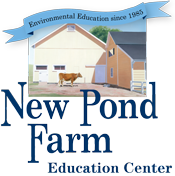by Mike Murray, Farm Manager
Often, visitors to New Pond Farm will ask where the sheep or cows are located on any particular day. This is because these animals frequently move to different areas of the Farm. We call it rotational grazing, and we use it for proper nutrition, growth and production.
Rotational grazing is the use of a large pasture area for high intensity, but low frequency grazing. The pasture is divided into paddocks, and the animals (dairy, beef, chickens, or sheep) are moved from paddock to paddock as they deplete each area of suitable forage. The timing of the rotations is based upon the growth rate of the vegetation (which varies depending upon weather conditions) and number of animals per paddock.
We graze the dairy and beef animals on five to seven different paddocks on the large New Pond Farm pasture land. Additionally, the sheep are rotated on a separate section of the pasture which is divided into five to seven paddocks with a moving fence system. The rotations provide the cows and sheep with a fresh supply of grass to eat every two to three days before they move to the next section. The chickens are rotated between three fenced pens surrounding the chicken coop building.
By moving the animals so often, the grass has time to rest. The rest period is critical for the plants to deepen root systems and rebuild energy reserves, which provides a more nutritional plant for use by the animals.
Grazing on strong, productive pasture is a happy, healthy way of life for the animals at New Pond Farm, and rotational grazing allows us to accomplish this goal. The next time you are here for a visit, take a look around to see where the chickens, cows, and sheep may be found. (Hint… they will be on fresh grass!)

Comments are closed.